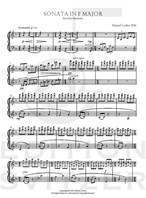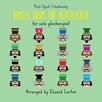
Sonata No. 2 in F-Major
Composer: Edzard Locher
Instrument: Marimba
Level: Advanced
Published: 2022
Price: €25.00
Item details
-
Description +
-
Preface
This marimba sonata is written in a "double-function-form" as in the words of musicologist William Newman (1912-2000). It's a single movement in classical sonata form, though cutting the repeat of the exposition and basically skipping the reprise in favor of a coda. It's also the most basic A-B-A form when seeing the musical characters of the calm introduction, wrought up middle section and quiescent conclusion. A third form layer occurs when combined with the two sisterworks, sonatas in A-major and c-minor. All three share this special formal structure, are thematically connected via a recurring "sister motif" and feature three quotes from works by danish composer Carl Nielsen (1865-1931).
-
-
Instrumentation +
-
Marimba (5-octave)
-
-
About the composer +
-
Edzard Locher (born 1989 in Tettnang, Lake Constance) studied percussion, composition and pedagogy in Zurich. He was percussionist with Kiel Philharmonic and Hof Symphony and is principal percussionist with Hessen State Orchestra Wiesbaden since 2016 as well as an associate professor at Wiesbaden Music Academy. He composes works for percussion and has specialized in percussion arrangements of classical music.
-
-
Reviews +
-
Percussive Notes, February 2023
This is an incredible piece of music! No gimmicks, no frills, just a meticulously crafted work of art that will offer advanced marimbists an amazing piece to explore. With “Sonata in F-major,” Edzard Locher has created a single sonata-form movement using what he refers to as a “double- function-form,” which means this piece can stand alone as a modified sonata form without the repeats and a truncated recap, or as a part of a three-song cycle with its sister pieces, “Sonata in A major” and “Sonata in C-minor.”
In addition to its carefully crafted form, “Sonata in F major” pushes the technical limits of the instrument, calling on the performer to voice chorale- like polyphony with many moving voices between the hands, often with intricate rhythms overtop sustained chords. Beyond the rapid flourishes and prevalent octaves now common in advanced marimba repertoire, Locher calls on the performer to execute musically challenging textures such as oscillating figures with changing interval sizes in one hand with long legato melodies underneath, and or nimble polyphonic melodies in each hand with the pair of hands moving in similar or contrary motion. While these textures are common in piano and organ literature, they are less prevalent in solo marimba music. Locher also takes full advantage of evolving marimba notation conventions with a plethora of notational symbols to aid the performer with interpreting the piece.
While Locher’s sonata does place technical demands on the performer, much of the piece is idiomatic and lays comfortably on the marimba. “Sonata in F-Major’’ is best suited for advanced marimbists. This piece would work well on a graduate or professional recital and is accessible for most audiences who are familiar with the chromaticism of the Romantic-era harmonic language, and the piece would likely stand out on a recital as a stunningly lyrical piece of music.
—Quintin Mallette
-
-
Credits +
-
With support from Koda’s Cultural Funds
Painting: "La Primevère" by Alfons Mucha (1860-1939)
Front Cover Design: Nicola Lee
Photo: Christoph Risch
Printed in Copenhagen, Denmark
Copyright © Edition SVITZER
www.editionsvitzer.com
-






